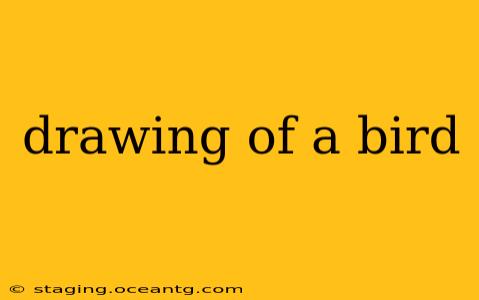Drawing a Bird: A Comprehensive Guide for Beginners and Beyond
Drawing a bird, whether a majestic eagle or a tiny hummingbird, can be a rewarding experience. This guide will walk you through the process, from basic shapes to adding intricate details, catering to both beginners and those looking to refine their skills. We'll cover everything from understanding bird anatomy to mastering different drawing techniques. Let's take flight!
What are the basic shapes to start with when drawing a bird?
Beginners often find it helpful to break down complex subjects into simpler forms. When drawing a bird, think of basic shapes like circles, ovals, and triangles. The body can often be represented by an oval, the head a circle, and the beak a triangle. The wings can be simplified as teardrop shapes or even elongated ovals. Using these foundational shapes as a framework helps establish the bird's overall posture and proportions before adding finer details.
How do I draw realistic bird feathers?
Drawing realistic feathers requires attention to detail and understanding their structure. Individual feathers are composed of a central shaft with barbs branching out. These barbs are further divided into barbules, creating a textured surface. Don't attempt to draw every single barbule; instead, focus on suggesting their texture through shading and line variation. Pay attention to the direction of feather growth and how they overlap to create volume. Consider using different pencil grades to show the subtle variations in light and shadow across the feather surface. Observe photographs or real birds to study the unique patterns and textures of different species.
What are the key features to focus on when drawing birds?
Capturing a bird's essence involves focusing on key anatomical features. These include the shape and size of the beak, which is often indicative of its diet. The eye's placement and expression convey personality and alertness. The proportions of the body, wings, and tail are crucial for accurately representing the species. Pay close attention to the bird's posture—is it perched, in flight, or preening? This posture informs the overall composition of the drawing. Understanding the bird's species will help you accurately render its unique features like crest, plumage, or tail shape.
How do I draw a bird in flight?
Drawing a bird in flight requires understanding aerodynamics and capturing the motion. Focus on the wing's curvature and the way it interacts with the air. Suggesting motion through blurred lines or dynamic poses is crucial. Start by sketching the basic shapes of the body and wings, paying attention to the angle of the wings and tail. Then, add details, focusing on the flow of the feathers and the sense of speed. Observe birds in flight to understand how their bodies and wings move.
What materials should I use to draw a bird?
The choice of materials depends on your preferred style and the level of detail you aim for. Graphite pencils offer versatility for sketching and shading. Charcoal pencils create darker, more expressive lines and shadows. Colored pencils allow for more realistic representation of plumage. Experiment with different mediums to find what best suits your artistic vision. Remember the quality of your paper can significantly influence the result; smooth paper works best for detailed drawings, while textured paper allows for a more expressive style.
How can I improve my bird drawing skills?
Consistent practice is key to improving your bird-drawing skills. Start with simple sketches, gradually increasing complexity. Study bird anatomy and behavior from books, photographs, and even live observation. Don't be afraid to experiment with different techniques and styles. Seek feedback from other artists and use online resources for inspiration and learning. Most importantly, enjoy the process and celebrate your progress. Drawing should be a fun and rewarding endeavor.
By following these guidelines and practicing regularly, you'll soon find yourself creating stunning and realistic bird drawings. Remember, observation and understanding are key to successfully capturing the beauty and complexity of avian life. Happy drawing!
